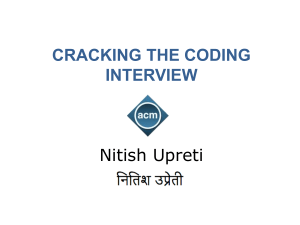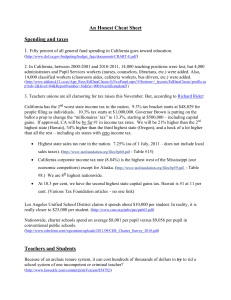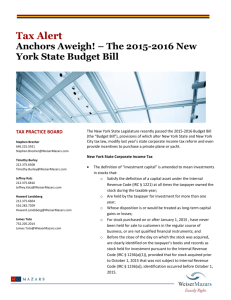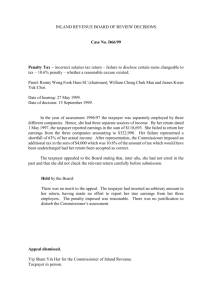Functional Analysis
advertisement
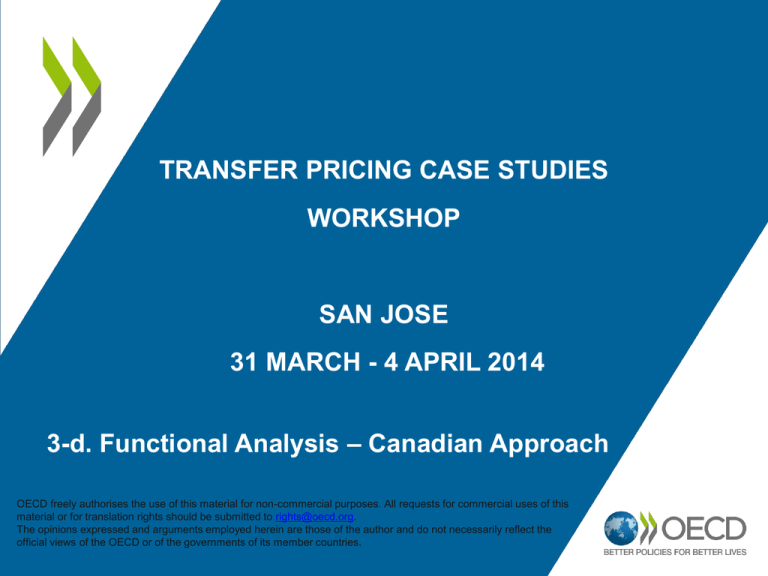
TRANSFER PRICING CASE STUDIES WORKSHOP SAN JOSE 31 MARCH - 4 APRIL 2014 3-d. Functional Analysis – Canadian Approach OECD freely authorises the use of this material for non-commercial purposes. All requests for commercial uses of this material or for translation rights should be submitted to rights@oecd.org. The opinions expressed and arguments employed herein are those of the author and do not necessarily reflect the official views of the OECD or of the governments of its member countries. Risk Assess the File • Knowledge of the Company, Industry and Business Structure: • Organisational charts; Annual Reports; “contemporaneous documentation”; Internet search for articles; filings with Securities Commissions. • Obtain contracts, agreements, etc. – look for internal CUPs, understand how the transactions are structured. • Obtain segmented financial statements: - analyse gross profit and operating profit of Domestic Company and foreign associated enterprise(s) - identify “system profit” • Clearly identify the transactions and the applicable treaty. 2 Factors Determining Comparability • 5 major factors: i. Characteristics of property or services ii. Functional analysis – Functions, Assets, Risks iii. Contractual terms iv. Economic circumstances v. Business strategies • Arm’s length principal - compare conditions in controlled transaction with conditions in uncontrolled transactions. • Determine if any “reasonably accurate adjustments” are necessary. • All TPMs are based on a certain degree of comparability. 3 Functional Analysis • • • • • • Why … What … When … Where … How … Who … 4 Functional Analysis - Why? • Critical audit step – verify that what is reported to the tax administration reflects what is actually being done. • So that we can determine: • tested party • most appropriate methodology • most appropriate comparables • Goal is to determine: who should get what for the functions performed; which parties are responsible for value-added activity? • Identify key profit drivers. • Need to support file for Appeals / Competent Authority / Court 5 Functional Analysis – Who • Go to the taxpayer’s premises to: – interview the taxpayer’s key personnel – do a tour of the premises – obtain thorough understanding of the domestic operations • Interview the people who are actually performing the functions. 6 Functional Analysis - What? What is functional analysis? = Functions performed; Assets used by all parties involved in the transaction; Risks assumed. • Functions: Production; Marketing; Distribution; Management; Administrative; Technology • Assets: Tangibles; Intangibles; Working Capital • Risks: Technological; Market; Credit; Foreign Exchange; Litigation; Inventory; Capital Investment 7 Functional Analysis - When? • On every single file! • It should be done for all related party transactions and/or product lines. • Done BEFORE making ANY determinations as to who is the tested party, what methodology will apply, or who the comparables will be. • Do not get into discussions of comparables with the taxpayer or their representatives until you have completed the functional analysis. 8 Functional Analysis - Where? • It is easy for a taxpayer to state what functions are performed in the other country, we need to verify the accuracy of their statements. • Visit the domestic operations, and go to the foreign jurisdiction (when possible). • Transfer pricing audits are not a desk job! • Level of detail will vary, case-by-case, and depending on the issue. 9 Functional Analysis - How? Before the Functional Analysis Interviews: • Understand the company and major functions so you interview the right people and ask the right questions. • Do not interview only the Director/VP levels; interview the people actually doing the job. • Use the Organisational Charts to identify people to interview. • Ask questions geared to that company and the specific industry and markets they operate in. 10 Functional Analysis – How? During the Functional Analysis Interviews: • Take detailed notes. • Team approach - two auditors on every interview – one to ask questions, one to take notes. • If taxpayer requests questions in advance, we explain that we will be asking questions that will help us get an understanding of their operations. It is basically, “What do you do?” “How do you do it?” Further questions then flow from their answers. 11 Functional Analysis – How? After the Functional Analysis Interviews: • Write up notes as soon as possible. • Must be factual, not opinions. • What to do if the taxpayer is delaying/not fully co-operating? • Taxpayer must provide documentary support for any facts they disagree with. • Do not debate methodologies or comparables before completing functional analysis 12 Functional Analysis – How? After the Functional Interviews: • Determine how to classify the entity; do not worry about “labels”. • Relate the functional analysis to profit drivers. • Using the functional analysis: • Determine tested party – least complex entity and/or most reliable information. • Determine the TPM • Find comparable transactions - similar levels of asset intensity, bearing similar risks 13 Conclusion The end goal is to determine if the terms and conditions in the controlled transaction are what we would see in a comparable uncontrolled transaction. 14 Questions and/or comments?







